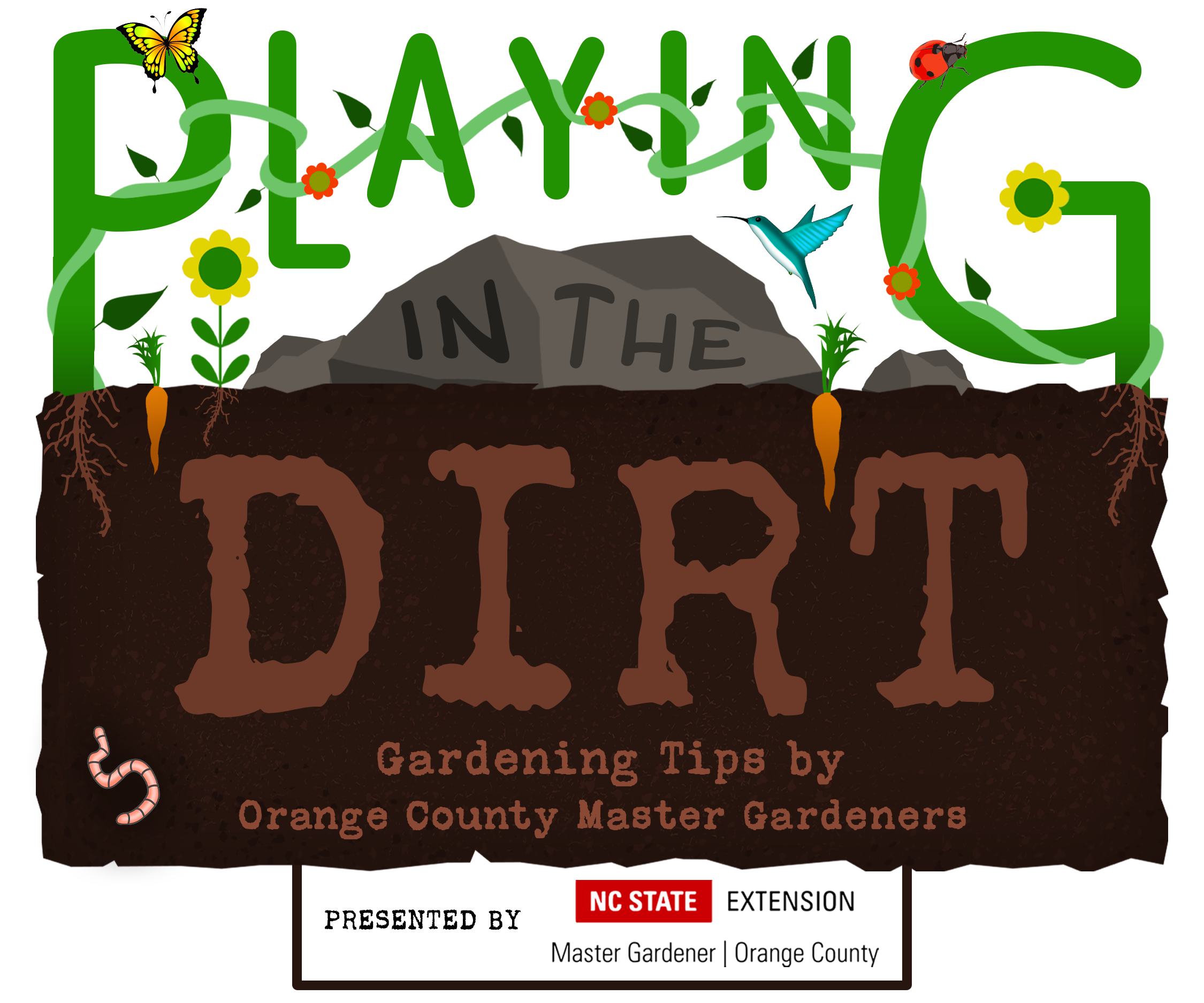
97.9 The Hill and Chapelboro.com have partnered with Orange County Master Gardeners for “Playing in the Dirt,” a monthly column exploring the fertile ground of home gardening in our community and intended to provide the information and inspiration gardeners of all skills levels need to flourish! Check back on Chapelboro each month for a new subject – from our gardens to yours!
By Ken Brockenbrough, Orange County Master Gardener volunteer
On cold evenings
my grandmother,
with ownership of half her mind–
the other half having flown back to Bohemia–
spread newspapers over the porch floor
so, she said, the garden ants could crawl beneath,
as under a blanket, and keep warm,
and what shall I wish for, for myself,
but, being so struck by the lightning of years,
to be like her with what is left, that loving.
“In Praise of Craziness of a Certain Kind,” by Mary Oliver
There are an endless number of ways to excite children about gardening and nature: from digging in the dirt, growing plants from seeds, discovering frogs and insects to reading books, and more. The key is to let them be part of the adventure and discover what they love for themselves. Ask any old-time gardener the key to their success and you’re likely to hear the phrase, “the right plant in the right place.” My mother, a pre-school teacher, used to correct me: “You raise corn and tomatoes, son; you rear children.” I think, however, she would agree that the old gardening adage applies to children as well: “the right child in the right place” is fundamental to successful human growth.
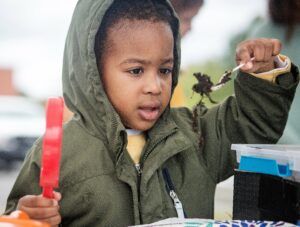
Discovering Worms! (Photo by Katie Rentzke.)
The word kindergarten means “garden of children.” The garden has been, and will continue to be, a place of mystery and wonder for growing children everywhere. While childhood and soil have a natural affinity for one another, the finest gardens and the finest children thrive in the presence of a catalyst: for the child, that is an older mentor. In “How to Raise a Wild Child, The Art and Science of Falling in Love With Nature,”* author Scott Sampson argues that to be a good mentor in outdoor spaces, one must be not only a teacher and advisor, but also a questioner and a trickster. This article will suggest some vital ingredients to successfully mentor children as they engage in gardening and experience nature.
The Right Place
Wouldn’t it be wonderful if each one of us had a nice little plot of land in the back yard, already loosened with organic material and open to plenty of sun? It isn’t necessary to have the perfect plot, though. Watch a child place a sugar pea in a wet paper towel and then marvel as the pea cracks open, germinates and a small green shoot emerges! Or watch that same child hover over a tiny hole under a lifted flagstone and feel the last wiggles of an earthworm escape her fingers. What you’re witnessing is awe and wonder.
The very best mentors — even those who know the Latin names of every plant in their yards — are those who retain a twinkle in their eyes and are just as surprised at age 60 when a December daffodil emerges as they were at age six. The mentor takes time to be present with the child, to sit and marvel at emerging life. If the mentor understands the delicate balance of photosynthesis and transpiration, they temporarily withhold that knowledge and ask the child: “How do you think that little radish seed got to be a plump tasty radish? Do you think it had more to do with something in the soil below, or was it sunlight and water on the leafy top?”
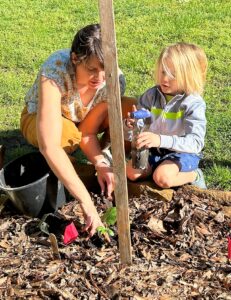
Planting Seedlings: Discovering the Right Place Together. (Photo by Ken Brockenbrough.)
The right place for a childhood garden is anywhere that is conducive to the mystery of life unfolding. I recently sat with a cluster of kindergartners as we witnessed onion seedlings in paper cups on a classroom windowsill reaching toward the sun. I remember my four-year-old daughter, now an adult, gleefully run up to me exclaiming, “I found a pasta-noodle in the compost pile!” She had actually found a nice fat grub, which turned out to be incredible catfish bait, and we share a memory we still enjoy. To find the right place, the key is to follow the inquiring mind of the child, then sit present together in whatever place constitutes their first garden and wait for wonders to unfold.
The Right Question
Many of us as young scientists recall squirming in tight little desks lined up in straight rows (usually in seats we didn’t choose), listening to our wise teacher talk about facts we were expected to recall and recite at week’s end on quiz day. However, if we were lucky, we knew one adult (if not a teacher, then a grandparent, aunt or neighbor) who probed our minds with stimulating questions. This adult was willing to let their own mind wander and go on walkabout with us.
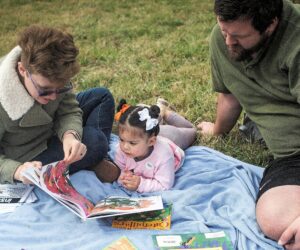
Nature Books: Stimulating Questions. (Photo by Katie Rentzke.)
Scott Sampson says there are two types of questions. The easier ones are those designed to increase the child’s confidence or mastery and usually build on knowledge already acquired. An example might be, “Why do you think potatoes and carrots are called root vegetables?” That could be followed by, “Can you think of any other vegetables that grow under the ground?” A harder question is one that takes the child to the edge of their understanding or experience and invites further exploration. For instance, you might ask the child, “Why do you think the potatoes you planted on the right side of your garden produced so many more potatoes than the ones you planted on the left?” It is crucial at this stage to withhold your own answers long enough for the child to ask their own questions in return.
The Trickster
According to Sampson: “Play is the signature of childhood. . . . [In play], effective mentors are almost invisible.” Perhaps you can recall a time as a child when you were lost, maybe in a hay-maze or a dense wood. There was something a little exciting about losing your way, being uncertain of the path back to homebase.
After asking the hard question, the mentor must be prepared to assume the identity of the novice, the child lost in wonder. This is not the time to look at your watch or discuss a planting agenda. This is the time to wait together for the garden to speak, to raise its own questions through the child, perhaps with thoughts you had never considered. Your time together began with a longing and desire not only to plan and create a garden, but also for a chance to let nature nurture you together. You might tell stories together. You recall a funny episode from your own childhood and the child responds by weaving her own experience into yours. There may be rows to plant, weeding to be finished, watering to be done; but the critical elements, as Mary Oliver eloquently says above, are to fall in love and to begin a journey that will last a lifetime, outlast your own lifetime and carry on into another.
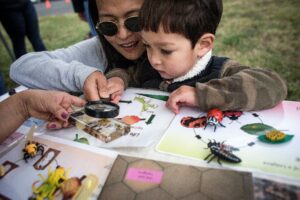
Take Time: Discover Together and Tell Stories. (Photo by Katie Rentzke.)
“I have a hard time rushing through the garden — any garden. For when one pauses, the heart of the garden, the beauty of the garden will wrap its arms around and embrace you. The garden should never be rushed through. It should be savored so that an imprint sinks in and lingers in one’s soul.”
John O’Donohue
Resources to Help Children Love Gardening and Nature:
- *Sampson, Scott D. (2015). How to Raise a Wild Child: The Art and Science of Falling in Love with Nature. Houghton Mifflin Harcourt.
- “Playing in the Dirt: Grow! Kids Learn While They Have Fun With Gardening” (July 8, 2021). Chapelboro.com.
- Grow For It (all kinds of information about youth and gardening). NC State Extension.
- Gardening With Young Children Helps Their Development. Michigan State University Extension.
- Gardening With Children – Let’s Talk Gardens (video). Smithsonian Gardens.
- Gardening With Children (ideas for activities with children). University of Tennessee, Knoxville.
Visit!
The North Carolina Botanical Garden in Chapel Hill and Duke Gardens in Durham both have children’s gardens and programs for children and families.
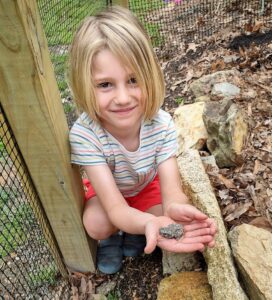
Unintended Consequences: The Magic of Garden Discovery! (Photo by Ken Brockenbrough.)
Check Us Out!
- Have a plant or garden question? Email the Orange County Master Gardener volunteers at ocmgardeners@gmail.com or phone 919-245-2061.
- Follow us on Facebook! Our page is Orange County NC Extension Master Gardener Volunteer.
- Subscribe to The Garden Buzz, the Orange County Master Gardeners’ monthly newsletter, for gardening news and tips. And visit our website, The Orange Gardener.
Chapelboro.com does not charge subscription fees, and you can directly support our efforts in local journalism here. Want more of what you see on Chapelboro? Let us bring free local news and community information to you by signing up for our biweekly newsletter.

